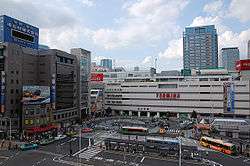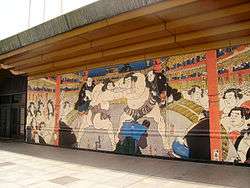Tokyo/Sumida
Sumida Ward (墨田区, sumida-ku) lies east of central Tokyo. It is home to a famous cherry blossom viewing area (along the Sumida River near Asakusa Station) in spring, the Sumida River Fireworks Festival (Hanabi Matsuri) in summer, and Tokyo's main sumo stadium (Ryogoku Kokugikan) where tournaments are held three times a year. It is also home to the Tokyo SkyTree, the world's tallest self-supporting tower.
The area is considered "shitamachi" (roughly translated as "old town"), though it has become a kind of bedroom community for Tokyoites, which has meant the building of many high-rise apartment buildings. Despite the boom in construction, the area retains its pre-WWII charm, with many small businesses and small neighborhood feel to it.
The Ryōgoku (両国) neighborhood, in the southwest portion of the ward, is nearly synonymous with sumō wrestling, one of Japan's most famous sports, where the human behemoths grapple and attempt to hoist each other out of the ring. The Edo-Tokyo Museum, an excellent and large museum on the history of Tokyo, is here, as well as a collection of quirky special-interest museums.
Get in

The JR Sobu Line (local service) runs east-west through Sumida, connecting to the Yamanote line across the river in Akihabara. Via subway, the Toei Oedo Line loops past the western edge of the ward with connections to both Ueno in the north and Shiodome to the south. On both lines, Ryogoku Station is the closest connection to most of the ward's main attractions.
Those going to Tokyo SkyTree can use the Tokyo Skytree Station on the Tobu Railway (one station from the Asakusa terminal station) or Oshiage-SkyTree on the Toei Asakusa Line and Tokyo Metro Hanzōmon Line.
See and do
🌍 Tokyo SkyTree (東京スカイツリー), 1-1-2 Oshiage (Tobu Railway to Tokyo Skytree Station, Toei Asakusa Subway Line/Tokyo Metro Hanzōmon Line to Oshiage-Skytree Station, or direct bus from Tokyo Station (30 minutes, ¥500)). Daily 08:00-22:00. Completed in 2012, the Tokyo Sky Tree stands tall over the old Sumida ward as the newest symbol of Tokyo and the world's tallest self-supporting tower. It is the primary location from which digital television broadcast signals in Tokyo are transmitted from. The tower's LED lighting system uses a different color scheme every night. The SkyTree is complemented by a shopping complex, Tokyo Skytree Town. Adults ¥2060 to the main deck, additional ¥1030 to the upper deck. International visitors can purchase fast track tickets from the Fast Skytree Ticket Counter on the 4th floor for ¥3000-4000 (Passport required).
Sumo

- 🌍
Ryōgoku Kokugikan (両国国技館), 1-3-28 Yokoami, ☎ +81 3-3623-5111 (Japanese). The largest sumo arena in Japan with a capacity for 10,000 spectators, this is where grand tournaments or basho are held in January, May and September, starting on the second Sunday of the month. These tournaments last for 15 days, and are filled with ceremony and ritual which observe strict hierarchies not just for the wrestlers, but also for the referees and callers. The competition each day begins around 9AM with the amateurs, and from there, wrestlers compete in progressing order of seniority. The professional wrestlers start around 2:35PM, but the excitement begins when the top division makuuchi (幕内) enter the ring in the dohyō-iri (土俵入り) ceremony at 3:50PM. The tournament culminates when the high-rank yokozuna (横綱) and ozeki (大関) have their bouts, around 6PM. If you have seats far from the ring, but arrive early, it is possible to borrow some seats close to the ring until mid-afternoon, when most spectators begin to arrive. English pamphlets describing the day's program and sumo in general are available, and radios with live English commentary can be rented. Food is available inside, at somewhat inflated prices. There are now signs prohibiting you from bringing in outside food and drink, but enforcement is spotty. Advance-booking Western-style chairs on the second floor are ¥3,600, ¥4,900 and ¥8,400; Japanese-style box seats on the first floor are ¥9,200, ¥10,300 and ¥11,300. These can be purchased at ticket outlets and convenience stores, starting the month before the match. You can buy unsold seats on the day of the tournament for ¥2,100, but only at the Kokugikan box office.
- 🌍 Sumo Museum (相撲博物館, sumō hakubutsukan), first floor of the Ryogoku Kokugikan, ☎ +81 3-3622-0366 (Japanese). 10AM-4:30PM weekdays only; closed weekends and holidays. A small, quirky museum tucked inside the arena's first floor, dedicated to the history of sumo, particularly artifacts and ceremonial clothing — unfortunately, almost entirely in Japanese only. The collection rotates several times a year. During sumo tournaments, it is open daily, but only to tournament ticket holders. Free.
- If you would like to reserve Sumo tournament tickets in advance, JTB group sells tour packages to Tokyo's three Sumo tournaments for ¥9800 per person, which includes a tour of the Sumo Museum and a second floor reserved seat to watch the afternoon Sumo matches. A meal package for ¥13,800 includes a post-match dinner where you can feast on Sumo's signature dish, Chanko-nabe (see below).
- Instead of peering at wrestlers through binoculars from the cheap seats at Kokugikan, you can see sumo up close and personal by visiting a sumo stable (heya) to watch the morning training, generally held from 6AM-10AM daily (and no, you don't have to stick around for the whole time). Advance arrangements will be necessary, preferably with the help of a Japanese speaker, and a "donation" of around ¥1,500 is expected. While watching the training, keep quiet and do not take flash photos. Note that many stables — particularly those with very famous wrestlers — do not permit visits. Isenoumi Stable has an informative (although increasingly outdated) English home page and is happy to arrange visits.
- Sumo Photo Museum (相撲写真資料館), 3-13-2 Ryogoku, ☎ +81 3-3631-2150. Open Tuesday only, but every day during sumo tournaments.
Museums
- 🌍 Edo-Tokyo Museum (江戸東京博物館 Edo-Tōkyō-hakubutsukan), 1-4-1 Yokoami (near Ryogoku subway station exits A3/A4; take the West exit from the JR station), ☎ +81 3-3626-9974. 9:30AM-5:30PM Tue-Sun; Sat until 7:30PM. Closed Mondays except during holidays or sumo tournament matches at nearby Ryōgoku.. One of the best museums in Tokyo, and that's saying something, this bizarre multi-story edifice suspended in midair and bearing not a small resemblance to a Star Wars Imperial Walker (meant to be a replica of an old raised warehouse) covers the history of the metropolis, starting from 1590 when it was selected as Japan's new capital Edo, all the way through the Kanto earthquake and firebombings of World War II. The museum is built with the latest technology including life-size replicas of entire buildings and the Nihombashi Bridge. Free informative tours are available in several languages, depending on which volunteers are around; audio guides in several languages always available. Pair it up with a visit to the more intimately sized Fukagawa Edo Museum in nearby Kōtō ward, just a couple of stops away on the Toei Ōedo subway line. ¥600.
- 🌍 The Japanese Sword Museum, 1-12-9,Yokoami, Sumidaku (7min walk from Ryogoku Station), ☎ +81 36284 1000. Tu-Su 09:30-17:00. All types of Japanese swords on display. Beautiful view from balcony on 3rd floor over Kyū Yasuda Garden. Quite hefty entrance fee. Nevertheless a must see for people interested in Japanese swords. ¥1000.
- 🌍 Tobacco and Salt Museum (たばこと塩の博物館 Tabako to Shio no Hakubutsukan). 10AM-6PM. This peculiar institution owes its existence to Japan's government monopoly on these two substances. The website advises that "dangerous substances are not permitted within the museum". They have map-guides of the museum in English and most exhibits have English translations. There is a free mobile-app based auto tour as well. ¥100.
- Paulownia Wood Furniture Museum (桐の博物館 kiri no hakubutsukan), 4-1-3 Ryogoku, ☎ +81 3-3632-0341. Th-Tu 10AM-6PM.
- 🌍 Ryogoku Fireworks Museum (両国花火資料館 ryōgoku hanabi shiryōkan), 2-10-8 Ryogoku, ☎ +81 3-5608-6181. Noon-4PM Th-Sa. Open daily Jul-Aug. Free.
- Tabi (Japanese socks) Museum (足袋資料館 tabi shiryōkan), 1-9-3 Midori, ☎ +81 3-3631-0092. M-Sa 9AM-5PM.
Buy
Eat
While in sumo town the thing to do is eat sumo food, namely the hearty chanko-nabe (ちゃんこ鍋) stew that forms the bulk of a rikishi's diet. Oddly, it's actually a fairly healthy dish of chicken, fish, tofu and vegetables cooked in broth, the wrestlers just seem to eat lots of it. Many a sumo wrestler sets up a chanko restaurant when they retire, and many of those establishments can be found here. Be warned that this is usually fairly expensive, with sets starting around ¥2,500/person. You'll want at least two people, and make reservations well in advance if planning to sample chanko when the basho is in town.
- 🌍 Chanko Tomoegata (巴潟), 2-17-6 Ryōgoku (3 min south from JR Ryōgoku West exit), ☎ +81 3-3632-5600. Open Tu-Su, lunch 11:30AM-2PM, dinner 5PM-11PM. One of Tokyo's oldest chanko joints, operating for over 100 years, specializing in a slightly unusual miso-flavored soup. Lunch sets at ¥840/1260 weekdays/weekends are just about the cheapest chanko you'll find anywhere and a good option for the solo traveller. Dinner starts from ¥2940/person for the Tomoegata (miso) or Yahazuyama (dashi) set and goes up to ¥8400 for the aptly humongous 9-course Yokozuna.
- 🌍 Mochicream (モチクリーム), Oshiage 1-10-3 (Exit B3 of the Oshiage/Skytree station, enter the Life Supermarket and find the Mochicream corner). A bag of ice cream contained in a small rice pudding bag. Grab one before starting your visit.
Drink
- Popeye Beer Club, 2-18-7 Ryogoku, ☎ +81 3-3633-2120. M-F 5PM-1AM, Sa 5PM-2AM, closed Su. Popeye's is an excellent place to try Japanese microbrews. There are 40 beers on tap, which cover the full range of beers from familiar ales to barley wines and rauchbiers. The food menu is interesting, try the avocado and blue cheese. English menus are available. Pints of beer are around ¥900, half pints and a sampler set are available.Note to travelers: Non-English friendly if you have problems asking about the menu or bill. Not a standing bar, you have to be seated and charged for that; hidden seating and cover charges are a nasty surprise when you get your bill. Not recommended for a casual drink.
Sleep
Accommodations are few, especially for non-Japanese speakers. Sleeping elsewhere in Tokyo and taking the train in for the day is the typical approach.
- Tobu Hotel Levant Tokyo (東武ホテル レバント東京), 1-2-2 Kinshi (3 minutes walk from JR Kinshi-cho station), ☎ +81 3-5611-5511.
- Lotte City Hotel Kinshicho (ロッテシティホテル錦糸町), 4-6-1 Kinshi (in front of JR kinshi-cho Station.), ☎ +81 3-5619-1066.
- Dai-ichi Hotel Ryogoku (第一ホテル両国), 1-6-1 Yokoami (1 minute walk from Oedo Subway Ryogoku Station A-1), ☎ +81 3-5611-5211.
Connect
Go next
The little Fukagawa Edo Museum in nearby Koto Ward (From Ryogoku Subway Station, take Oedo line to Kiyosumi-Shirakawa Station, exit A3) is a nice complement to the Edo-Tokyo Museum. Kiyosumi Garden is nearby.
| Routes through Sumida |
| Tokyo ← | W |
→ Shin Koiwa → Funabashi → Chiba |
| Akihabara ← Asakusabashi ← | W |
→ Kameido → Ichikawa → Chiba |
| END ← | W |
→ Keisei Takasago → Keisei Funabashi → Narita |
| Asakusa ← | W |
→ Nishi Arai → Koshigaya → into |
| END ← | N |
→ Asakusa → Shinbashi → into |
| Shinjuku ← Kudanshita ← Iwamotocho ← | W |
→ Ojima → Motoyawata |
| Shinjuku ← Kasuga ← Ueno Okachimachi ← | W |
→ Kiyosumi Shirakawa → Monzen-Nakacho → Tsukiji market |
| Shibuya ← Jinbocho ← Kiyosumi Shirakawa ← | W |
→ END |
| into |
N |
→ Hakozaki → into |
| into |
W |
→ Komatsugawa →into |